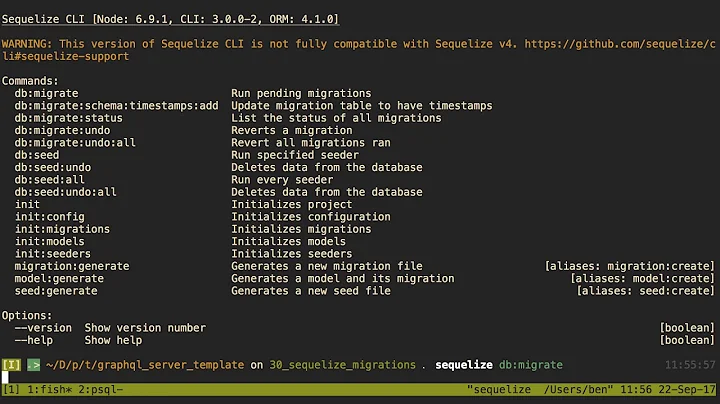How to auto generate migrations with Sequelize CLI from Sequelize models?
Solution 1
If you don't want to recreate your model from scratch, you can manually generate a migration file using the following CLI command:
sequelize migration:generate --name [name_of_your_migration]
This will generate a blank skeleton migration file. While it doesn't copy your model structure over to the file, I do find it easier and cleaner than regenerating everything. Note: make sure to run the command from the containing directory of your migrations directory; otherwise the CLI will generate a new migration dir for you
Solution 2
You cannot create migration scripts for existing models.
Resources:
If going the classic way, you'll have to recreate the models via the CLI:
sequelize model:create --name MyUser --attributes first_name:string,last_name:string,bio:text
It will generate these files:
models/myuser.js:
"use strict";
module.exports = function(sequelize, DataTypes) {
var MyUser = sequelize.define("MyUser", {
first_name: DataTypes.STRING,
last_name: DataTypes.STRING,
bio: DataTypes.TEXT
}, {
classMethods: {
associate: function(models) {
// associations can be defined here
}
}
});
return MyUser;
};migrations/20150210104840-create-my-user.js:
"use strict";
module.exports = {
up: function(migration, DataTypes, done) {
migration.createTable("MyUsers", {
id: {
allowNull: false,
autoIncrement: true,
primaryKey: true,
type: DataTypes.INTEGER
},
first_name: {
type: DataTypes.STRING
},
last_name: {
type: DataTypes.STRING
},
bio: {
type: DataTypes.TEXT
},
createdAt: {
allowNull: false,
type: DataTypes.DATE
},
updatedAt: {
allowNull: false,
type: DataTypes.DATE
}
}).done(done);
},
down: function(migration, DataTypes, done) {
migration.dropTable("MyUsers").done(done);
}
};Solution 3
It's 2020 and many of these answers no longer apply to the Sequelize v4/v5/v6 ecosystem.
The one good answer says to use sequelize-auto-migrations, but probably is not prescriptive enough to use in your project. So here's a bit more color...
Setup
My team uses a fork of sequelize-auto-migrations because the original repo is has not been merged a few critical PRs. #56 #57 #58 #59
$ yarn add github:scimonster/sequelize-auto-migrations#a063aa6535a3f580623581bf866cef2d609531ba
Edit package.json:
"scripts": {
...
"db:makemigrations": "./node_modules/sequelize-auto-migrations/bin/makemigration.js",
...
}
Process
Note: Make sure you’re using git (or some source control) and database backups so that you can undo these changes if something goes really bad.
- Delete all old migrations if any exist.
- Turn off
.sync() - Create a mega-migration that migrates everything in your current models (
yarn db:makemigrations --name "mega-migration"). - Commit your
01-mega-migration.jsand the_current.jsonthat is generated. - if you've previously run
.sync()or hand-written migrations, you need to “Fake” that mega-migration by inserting the name of it into your SequelizeMeta table.INSERT INTO SequelizeMeta Values ('01-mega-migration.js'). - Now you should be able to use this as normal…
- Make changes to your models (add/remove columns, change constraints)
- Run
$ yarn db:makemigrations --name whatever - Commit your
02-whatever.jsmigration and the changes to_current.json, and_current.bak.json. - Run your migration through the normal sequelize-cli:
$ yarn sequelize db:migrate. - Repeat 7-10 as necessary
Known Gotchas
- Renaming a column will turn into a pair of
removeColumnandaddColumn. This will lose data in production. You will need to modify the up and down actions to userenameColumninstead.
For those who confused how to use
renameColumn, the snippet would look like this. (switch "column_name_before" and "column_name_after" for therollbackCommands)
{
fn: "renameColumn",
params: [
"table_name",
"column_name_before",
"column_name_after",
{
transaction: transaction
}
]
}
-
If you have a lot of migrations, the down action may not perfectly remove items in an order consistent way.
-
The maintainer of this library does not actively check it. So if it doesn't work for you out of the box, you will need to find a different community fork or another solution.
Solution 4
You can now use the npm package sequelize-auto-migrations to automatically generate a migrations file. https://www.npmjs.com/package/sequelize-auto-migrations
Using sequelize-cli, initialize your project with
sequelize init
Create your models and put them in your models folder.
Install sequelize-auto-migrations:
npm install sequelize-auto-migrations
Create an initial migration file with
node ./node_modules/sequelize-auto-migrations/bin/makemigration --name <initial_migration_name>
Run your migration:
node ./node_modules/sequelize-auto-migrations/bin/runmigration
You can also automatically generate your models from an existing database, but that is beyond the scope of the question.
Solution 5
I created a small working "migration file generator". It creates files which are working perfectly fine using sequelize db:migrate - even with foreign keys!
You can find it here: https://gist.github.com/manuelbieh/ae3b028286db10770c81
I tested it in an application with 12 different models covering:
STRING, TEXT, ENUM, INTEGER, BOOLEAN, FLOAT as DataTypes
Foreign key constraints (even reciprocal (user belongsTo team, team belongsTo user as owner))
Indexes with
name,methodanduniqueproperties
Related videos on Youtube
Michael Schmidt
Updated on September 02, 2021Comments
-
Michael Schmidt over 2 years
I have a set of Sequelize models. I want to use migrations, not DB Sync.
Sequelize CLI seems to be able to do this, according to this article: "When you use the CLI for the model generation, you will gain the migration scripts for free as well."
How to auto generate the migrations with Sequelize CLI from existing Sequelize models?
-
Sunil Sharma about 8 years"this article" link is not working. :(
-
Ben Creasy over 7 yearsKeep an eye on github.com/sequelize/cli/issues/257
-
-
 Zeeshan Jan almost 9 yearsThanks @Dor I have few questions around the sync functinality using sequelize. As I understand sequelize-cli uses Umzug internally for doing all the migrations. The example you showed really helped me to get started but what is the procedure for Alter Table, suppose I would like to alter the MyUser model in sequelize and let sequelize cli create the migration script for me , how can sequelize cli create the migration script by going through all the model changes.
Zeeshan Jan almost 9 yearsThanks @Dor I have few questions around the sync functinality using sequelize. As I understand sequelize-cli uses Umzug internally for doing all the migrations. The example you showed really helped me to get started but what is the procedure for Alter Table, suppose I would like to alter the MyUser model in sequelize and let sequelize cli create the migration script for me , how can sequelize cli create the migration script by going through all the model changes. -
Dor Rotman almost 9 yearsGenerally you need to separate between the sync ability, which is good for a new DB or for a demo, and between migrations. When you have a production system that you continually upgrade and don't want to lost the data, then migrations is probably your only option. Unfortunately, the CLI is only good for creating basic templates, it runs no special logic and does not scan your model. (I was disappointing of this as well.) You need to create the migrations to transform the schema/data, and you need to change the model to the represent the newest schema as if that's how it's always been.
-
 Zeeshan Jan almost 9 yearsThanks @Dor but it seems lot of work to write the migration script for the changes. I wish somehow the migration scripts could be avoided and sync can happen by default.
Zeeshan Jan almost 9 yearsThanks @Dor but it seems lot of work to write the migration script for the changes. I wish somehow the migration scripts could be avoided and sync can happen by default. -
Dor Rotman almost 9 yearsSo do I. However if you look at ActiveRecord and Entity Framework ORMs, this is the pattern they implement as well.
-
 Zeeshan Jan almost 9 yearssure but they also provide a feature where we could generate the DBML file (In case of Entity Framework) directly using the database first or model first approach. They allow a developer to make changes in the database and then on the press of a button we could get models from Entity Framework.
Zeeshan Jan almost 9 yearssure but they also provide a feature where we could generate the DBML file (In case of Entity Framework) directly using the database first or model first approach. They allow a developer to make changes in the database and then on the press of a button we could get models from Entity Framework. -
Alex Booker over 8 years@DorRotman Thanks for clarifying this. This is really disappointing as I, too, have been spoiled by Entity Framework...
-
alexsc over 8 yearsHello, how can I specify relationships (class associations) within the cli ? Or, if I add them to the model, will them be valid ?
-
 Manuel Bieh over 8 yearsI've modified my script above to generate static migration files for each model (in a
Manuel Bieh over 8 yearsI've modified my script above to generate static migration files for each model (in a./tmpfolder): gist.github.com/manuelbieh/606710b003b5fe448100 - as I already stated above: i have no idea if there are any negative sideeffects so use it with caution! -
 trendsetter37 over 8 yearsWhat does your models directory look like? Are you still using the index.js script that sequelize recommends?
trendsetter37 over 8 yearsWhat does your models directory look like? Are you still using the index.js script that sequelize recommends? -
user3631341 about 8 yearsI get [SyntaxError: Unexpected reserved word]
-
Dor Rotman about 8 yearsWARNING: This is contrary to the whole migration model. If you'd want to just create the tables each time from the model, you could use the sync() function of Sequelize. However, it does not solve the problem of upgrading a production server that just needs a field added to a table. The only way to achieve this is by manually writing the migrations. Migrations rely on previous ones that have run historically. Having a single migration and rewriting it each time with different model - will simply not run, as the SequelizeMeta table indicates the migration has already run on that server before.
-
Dor Rotman about 8 yearsMoreover, imagine this scenario: the create-tables migration creates all tables from the model, as they look when compiling or building the installation package. You deploy a server and run the migration during deployment. Later, you create a migration that only adds a field. You upgrade the server. Everything works. Then you need to install a new server. That server would run the create-tables migration that already contains the field, and then would run the next migration that only adds a field. The 2nd migration will fail as the field already exists. Conclusion: Migrations can never change.
-
 Supawat Pusavanno over 7 yearsI agreed with @DorRotman. I think to initialize the database the first time, use sequelize.sync is the best, after the initialize (may be the app on prod for a while) then use the migration to add/modify columns, add more models etc.
Supawat Pusavanno over 7 yearsI agreed with @DorRotman. I think to initialize the database the first time, use sequelize.sync is the best, after the initialize (may be the app on prod for a while) then use the migration to add/modify columns, add more models etc. -
sebastien.b over 7 yearsand yet the video you are linking to does show he is able to create migrations from existing models (see when he typed
stukko addMigrationafter 5:40). -
Ulises Vargas De Sousa over 7 yearsWhere you store that file?
-
czerasz over 7 yearsI think your code does something similar to
models.sequelize.sync({force: true})(just a little bit more complex). If you change the model there is no way to update your schema because the migration already run (that's why you dodb:migrate:undo:all). Migrations should version your DB schema. It's a nice example (I learned few commands) but I wouldn't use it inproduction. -
 Zeke Nierenberg about 7 yearsI agree, this takes away the power of migrations. What happens when the model code changes? The migration will have different behavior. Migrations should almost read like a git commit. It would be awesome to have a script that generated a migration for a specific point in time, and it could probably leverage what you're doing here.
Zeke Nierenberg about 7 yearsI agree, this takes away the power of migrations. What happens when the model code changes? The migration will have different behavior. Migrations should almost read like a git commit. It would be awesome to have a script that generated a migration for a specific point in time, and it could probably leverage what you're doing here. -
 Dakusan about 7 yearsJust to note for anyone that tries this script, it is strictly for mysql
Dakusan about 7 yearsJust to note for anyone that tries this script, it is strictly for mysql -
 CodeTrooper about 6 yearsHow do I run this?
CodeTrooper about 6 yearsHow do I run this? -
BrinkDaDrink almost 6 yearsthis is never talked about but needed when making migrations to add or remove columns especially if you want to have those update a production environment latter.
-
Muhammad Umer almost 6 years
-
 Thierry J. over 5 yearsNote that this does not generate down migrations.
Thierry J. over 5 yearsNote that this does not generate down migrations. -
 PirateApp over 4 yearsnewbie to sequelize and confused, if I create a model the cli creates the migrations automatically, but if I create the model manually, does the CLI scan the model and generate the migrations in any way? also by default the model has no code for validating or associating, do I have to make changes to both the model and migrations for such things? can I add a foreign key to the model and run a magic command that generates the migration accordingly, can someone please clarify these things
PirateApp over 4 yearsnewbie to sequelize and confused, if I create a model the cli creates the migrations automatically, but if I create the model manually, does the CLI scan the model and generate the migrations in any way? also by default the model has no code for validating or associating, do I have to make changes to both the model and migrations for such things? can I add a foreign key to the model and run a magic command that generates the migration accordingly, can someone please clarify these things -
Sento over 4 yearsYou can run
npx sequelize-cli migration:generate --name [name_of_your_migration]from root of your project. But before you do so, you need to tell sequelize-cli where to generate your migrations, sequelize-cli uses config calledmigrations-pathfor this. sequelize.org/master/manual/… -
Sebi2020 over 4 yearsYou shouldn't use drop to undo the migration. This does not match the purpose of migrating data. You will lost all your of your user data if you undo a migration, which is not the purpose of migrations.
-
Sebi2020 over 4 yearsYou shouldn't use drop to undo the migration. This does not match the purpose of migrating data. You will lost all your of your data if you undo a migration, which is not the purpose of migrations.
-
 YulePale over 4 yearsi keep getting "UNKNOWN_VALUE: Unknown value: mega-migrations" error. Why is this happening?
YulePale over 4 yearsi keep getting "UNKNOWN_VALUE: Unknown value: mega-migrations" error. Why is this happening? -
 YulePale over 4 yearsDoes this work with sequelize version 5.x.x? I know you have hinted it in the answer but I've been trying for hous to make it work but still doesn't?
YulePale over 4 yearsDoes this work with sequelize version 5.x.x? I know you have hinted it in the answer but I've been trying for hous to make it work but still doesn't? -
PaulMest over 4 yearsI have only tested this on Sequelize 5.x. and it works correctly for my team.
-
 YulePale over 4 yearsI have it working but it won’t take the name option it keeps on throwing an error. I am using windows. Any idea hw to solve this?
YulePale over 4 yearsI have it working but it won’t take the name option it keeps on throwing an error. I am using windows. Any idea hw to solve this? -
PaulMest over 4 yearsOh. Just don't use the
--nameoption then. It is optional. It will then create01-noname.js... and you can manually rename this file. -
 YulePale over 4 yearsThanks, that is a simple and effective solution. Will do that.
YulePale over 4 yearsThanks, that is a simple and effective solution. Will do that. -
 YulePale over 4 yearsI have just tested it. When I alter the column name. The migration file deletes the column and creates a new one therefore the data in that column is lost. Have you noticed that behavior?
YulePale over 4 yearsI have just tested it. When I alter the column name. The migration file deletes the column and creates a new one therefore the data in that column is lost. Have you noticed that behavior? -
PaulMest over 4 yearsYes. When altering column names, the diff engine doesn't know that it's the same column so you'll need to manually change the auto-generated migration to use
renameColumninstead ofremoveColumnandaddColumn. -
Neithan Max over 4 yearsIt doesn't work for me either. It generates a migration file with my table names but that's it: no columns, no schema, nada.
-
Neithan Max over 4 yearsThis is not answering at all the question. It just generates a skeleton, there's no data in it, which is what OP is asking
-
Neithan Max over 4 yearsAfter hours of being stuck...Thank you! You are a gentleman and a scholar
-
Kallaste over 4 years@CarlesAlcolea My guess would be there is something wrong with your models. Please post a separate question.
-
Claudio Novoa about 4 yearsThanks, this was really useful. Anyways, it'd be sweet we could do what the OP asks for.
-
 Glenn Posadas about 4 yearsHey! Thanks for this. Works well! :) Helped me a lot! I'm a newbie in node-express+Sequelize.
Glenn Posadas about 4 yearsHey! Thanks for this. Works well! :) Helped me a lot! I'm a newbie in node-express+Sequelize. -
 LucasP almost 4 yearsThis worked for me on v6. The only point of failure was that Sequelize.NOW is not translated well and gives a syntax error on the migration. Other than that i had no problemas. Thanks!
LucasP almost 4 yearsThis worked for me on v6. The only point of failure was that Sequelize.NOW is not translated well and gives a syntax error on the migration. Other than that i had no problemas. Thanks! -
xanderflood over 3 yearsThanks @DorRotman - I really wish the "you are responsible for maintaining consistency between your migration files and model files" were explicitly addressed in the sequelize doc, as it's a HUGE detail
-
 entithat over 3 yearsI'm getting
entithat over 3 yearsI'm gettingERROR: Unexpected identifier. What should I do? -
Pablo almost 3 yearsThis tool is great. It works with your es6 models, it can detect renamed columns AND it can revert migrations!





